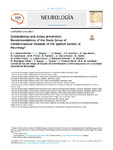Dyslipidemias and stroke prevention: recommendations of the Study Group of Cerebrovascular Diseases of the Spanish Society of Neurology

Use este enlace para citar
http://hdl.handle.net/2183/37272
A non ser que se indique outra cousa, a licenza do ítem descríbese como Creative Commons Attribution-NonCommercial-NoDerivs 4.0 International License (CC-BY-NC-ND 4.0)
Coleccións
- Investigación (FCS) [1293]
Metadatos
Mostrar o rexistro completo do ítemTítulo
Dyslipidemias and stroke prevention: recommendations of the Study Group of Cerebrovascular Diseases of the Spanish Society of NeurologyTítulo(s) alternativo(s)
Dislipidemias y prevención del ictus: recomendaciones del Grupo de Estudio de Enfermedades Cerebrovasculares de la Sociedad Española de NeurologíaAutor(es)
Data
2022-01Cita bibliográfica
Palacio-Portilla EJ, Roquer J, Amaro S, Arenillas JF, Ayo-Martín O, Castellanos M, Freijo MM, Fuentes B, García-Pastor A, Gomis M, Gómez-Choco M, López-Cancio E, Martínez-Sánchez P, Morales A, Rodríguez-Yáñez M, Segura T, Serena J, Vivancos-Mora J, de Leciñana MA; Comité ad hoc del Grupo de Estudio de Enfermedades Cerebrovasculares de la Sociedad Española de Neurología. Dyslipidemias and stroke prevention: recommendations of the Study Group of Cerebrovascular Diseases of the Spanish Society of Neurology. Neurologia (Engl Ed). 2022 Jan-Feb;37(1):61-72. English, Spanish.
Resumo
[Abstract]
Objective: We present an update of the Spanish Society of Neurology's recommendations for prevention of both primary and secondary stroke in patients with dyslipidaemia.
Development: We performed a systematic review to evaluate the main aspects of the management of dyslipidaemias in primary and secondary stroke prevention and establish a series of recommendations.
Conclusions: In primary prevention, the patient's vascular risk should be determined in order to define target values for low-density lipoprotein cholesterol. In secondary prevention after an atherothrombotic stroke, a target value <55 mg/dL is recommended; in non-atherothombotic ischaemic strokes, given the unclear relationship with dyslipidaemia, target value should be established according to the vascular risk group of each patient. In both primary and secondary prevention, statins are the drugs of first choice, and ezetimibe and/or PCSK9 inhibitors may be added in patients not achieving the target value. [Resumen] Objetivo. Actualizar las recomendaciones de la Sociedad Española de Neurología para la prevención del ictus, tanto primaria como secundaria en pacientes con dislipidemia.
Desarrollo. Se ha realizado una revisión sistemática en Pubmed evaluando los principales aspectos relacionados con el manejo de las dislipidemias en la prevención primaria y secundaria del ictus, elaborándose una serie de recomendaciones relacionadas con los mismos.
Conclusiones. En prevención primaria se recomienda determinar el riesgo vascular del paciente con el fin de definir los objetivos de LDLc. En prevención secundaria tras un ictus de origen aterotrombótico se recomienda un objetivo de LDLc < 55 mg/dl, mientras que en ictus isquémicos de origen no aterotrombótico dado que su relación con dislipidemias es incierta se establecerán los objetivos en base al grupo de riesgo vascular de cada paciente. Tanto en prevención primaria como secundaria las estatinas son los fármacos de primera elección, pudiendo asociarse ezetimiba y/o inhibidores de PCSK9 en aquellos casos que no alcancen los objetivos terapéuticos.
Palabras chave
Stroke
Dyslipidemia
Prevention
LDL cholesterol
Statins
Ictus
Dislipidemia
Prevención
Estatinas
Dyslipidemia
Prevention
LDL cholesterol
Statins
Ictus
Dislipidemia
Prevención
Estatinas
Descrición
Practice guideline
Versión do editor
Dereitos
Creative Commons Attribution-NonCommercial-NoDerivs 4.0 International License (CC-BY-NC-ND 4.0)
ISSN
2173-5808






